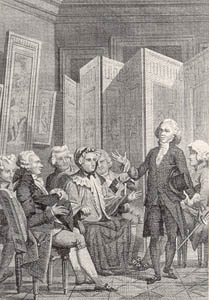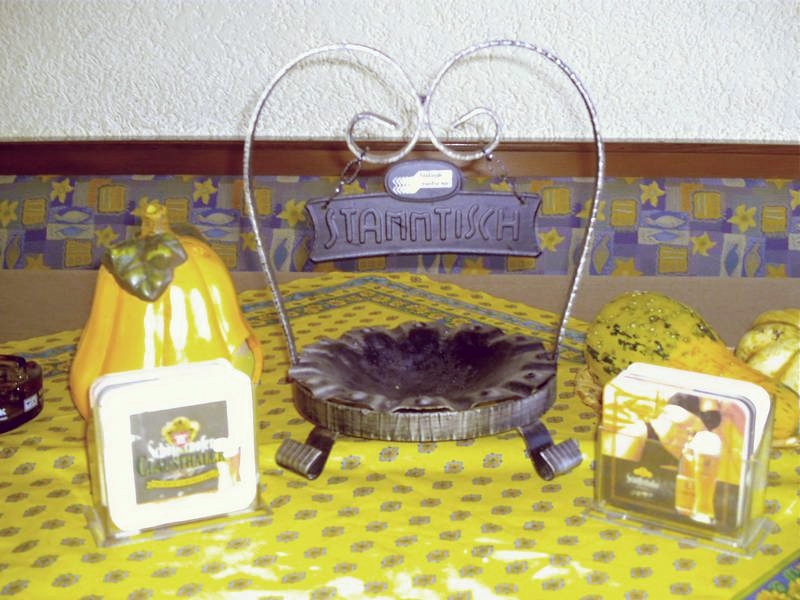|
Tertulia
A tertulia (, ; pt, tertúlia ; ca, tertúlia ) is a social gathering with literary or artistic overtones, especially in Iberia or in Spanish America. Tertulia also means an informal meeting of people to talk about current affairs, arts, etc. The word is originally Spanish (borrowed by Catalan and Portuguese), but it has only moderate currency in English, used mainly in describing Latin cultural contexts. Format A tertulia is rather similar to a salon, but a typical tertulia in recent centuries has been a regularly scheduled event in a public place such as a bar, although some tertulias are held in more private spaces, such as someone's living room. Participants, known as ''contertulios'', may share their recent creations such as poetry, short stories, other writings, and even artwork or songs. Usually, but not always, the participants in a regularly scheduled tertulia are in some respects like-minded, with similar political or literary tastes. Etymology Philip II of Spain ... [...More Info...] [...Related Items...] OR: [Wikipedia] [Google] [Baidu] |
Salon (gathering)
A salon is a gathering of people held by an inspiring host. During the gathering they amuse one another and increase their knowledge through conversation. These gatherings often consciously followed Horace's definition of the aims of poetry, "either to please or to educate" (Latin: ''aut delectare aut prodesse''). Salons in the tradition of the French literary and philosophical movements of the 17th and 18th centuries were carried on until as recently as the 1920s in urban settings. Historical background The salon was an Italian invention of the 16th century, which flourished in France throughout the 17th and 18th centuries. The salon continued to flourish in Italy throughout the 19th century. In 16th-century Italy, some brilliant circles formed in the smaller courts which resembled salons, often galvanized by the presence of a beautiful and educated patroness such as Berta Zuckerkandl, Isabella d'Este or Elisabetta Gonzaga. Salons were an important place for the exchange of id ... [...More Info...] [...Related Items...] OR: [Wikipedia] [Google] [Baidu] |
Pulqueria
Pulquerías (or pulcherías) are a type of tavern in Mexico that specialize in serving an alcoholic beverage known as pulque. Established during early colonial rule, pulquerías remained popular venues for Mexican socializing until the mid-20th century. They were associated with extravagant decorations and names, social drinking, music, dancing, gambling, fighting, crime, and sexual promiscuity. Central to daily life and culture in Mexico, government authorities throughout history generally saw them as threats to the social order and the progress of the nation. Numerous restrictions were later put on pulquerías and the sale of pulque. Today, there are very few pulquerías left operating in Mexico. Pulque production Pulque is a milky, foamy, alcoholic beverage native to central Mexico and made from fermented maguey sap,"What Is Pulque?" ''Del Maguey''. N.p., n.d. 20 December 2013. similar to tequila and mescal but with a much lower alcohol content, between 3 and 4%. The maguey ... [...More Info...] [...Related Items...] OR: [Wikipedia] [Google] [Baidu] |
Juan De Mal Lara
Juan de Mal Lara (Sevilla, 1524 – Sevilla, 1571) was a Spanish humanist, poet, playwright and paremiologue at the University of Seville during the period of the Spanish Renaissance in the reign of Philip II of Spain. Biography Mal Lara studied Latin and Greek grammar at the College of San Miguel in Sevilla. His teacher was Pedro Fernandez de Castilleja and later Mal Lara taught humanities to Mateo Alemán. It was a decade later, after studying at the University of Salamanca, where he was student of Hernán Núñez one of classmates was Francisco Sánchez de las Brozas, known as the "Brocense"; later he went to Valencia and Barcelona, where he completed his studies with Francisco Escobar before returning again to Salamanca. In 1548 he returned to Seville to study arts. By 1550 he taught at humanities and literature in a grammar school in Sevilla. In 1565, the Count of Gelves in Seville, established his "Merlin's Garden" in the fields near Tablada, and this became a regular gath ... [...More Info...] [...Related Items...] OR: [Wikipedia] [Google] [Baidu] |
Iberian Peninsula
The Iberian Peninsula (), ** * Aragonese and Occitan: ''Peninsula Iberica'' ** ** * french: Péninsule Ibérique * mwl, Península Eibérica * eu, Iberiar penintsula also known as Iberia, is a peninsula in southwestern Europe, defining the westernmost edge of Eurasia. It is principally divided between Spain and Portugal, comprising most of their territory, as well as a small area of Southern France, Andorra, and Gibraltar. With an area of approximately , and a population of roughly 53 million, it is the second largest European peninsula by area, after the Scandinavian Peninsula. Name Greek name The word ''Iberia'' is a noun adapted from the Latin word "Hiberia" originating in the Ancient Greek word Ἰβηρία ('), used by Greek geographers under the rule of the Roman Empire to refer to what is known today in English as the Iberian Peninsula. At that time, the name did not describe a single geographical entity or a distinct population; the same name was ... [...More Info...] [...Related Items...] OR: [Wikipedia] [Google] [Baidu] |
Flora Azcuénaga
Flora Azcuénaga (1767-1850) was an Argentinian philanthropist. In 1823, she was one of the founders of the famous philanthropic society ''Sociedad de Beneficencia The Sociedad de Beneficencia de Buenos Aires, also known as Sociedad de Damas de Beneficencia or simply Sociedad de Beneficencia (English: Society of Beneficence), was an Argentine state institution. The association was created by president Bernardi ...''. References * Cutolo, Vicente Osvaldo (1968). Nuevo diccionario biográfico argentino (1750-1930). Buenos Aires: Editorial Elche. {{DEFAULTSORT:Azcuenaga, Flora 1850 deaths 19th-century Argentine people Argentine philanthropists 1767 births 18th-century Argentine people 18th-century Argentine women 19th-century Argentine women ... [...More Info...] [...Related Items...] OR: [Wikipedia] [Google] [Baidu] |
Latin American Culture
Latin American culture is the formal or informal expression of the people of Latin America and includes both high culture (literature and high art) and popular culture (music, folk art, and dance), as well as religion and other customary practices. These are generally of Western origin, but have various degrees of Native American, African and Asian influence. Historical background Definitions of Latin America vary. From a cultural perspective, Latin America generally refers to those parts of the Americas whose cultural, religious and linguistic heritage can be traced to the Latin culture of the late Roman Empire. This would include areas where Spanish, Portuguese, French and various other Romance languages, which can trace their origin to the Vulgar Latin spoken in the late Roman Empire, are natively spoken. Such territories include almost all of Mexico, Central America and South America, with the exception of English or Dutch speaking territories. Culturally, it could als ... [...More Info...] [...Related Items...] OR: [Wikipedia] [Google] [Baidu] |
Spanish Culture
The culture of ''Spain'' is based on a variety of historical influences, primarily based on the culture of ancient Rome, Spain being a prominent part of the Greco-Roman world for centuries, the very name of Spain comes from the name that the Romans gave to the country, Hispania. Other ancient peoples such as Greeks, Tartessians, Celts, Iberians, Celtiberians, Phoenicians and Carthaginians also had some influence. In the areas of language and also religion, the Ancient Romans left a lasting legacy in the Spanish culture because Rome created Hispania as a political, legal and administrative unit. The subsequent course of Spanish history added other elements to the country's culture and traditions. The Visigothic Kingdom left a united Christian Hispania that was going to be welded in the ''Reconquista''. The Visigoths kept the Roman legacy in Spain between the fall of the Roman Empire and the Early Middle Ages. Muslim influences remained during the Middle Ages in the areas conquered ... [...More Info...] [...Related Items...] OR: [Wikipedia] [Google] [Baidu] |
Viennese Café
The Viennese coffee house (german: das Wiener Kaffeehaus, bar, as Weana Kafeehaus) is a typical institution of Vienna that played an important part in shaping Viennese culture. Since October 2011 the "Viennese Coffee House Culture" is listed as "Intangible Cultural Heritage" in the Austrian inventory of the "National Agency for the Intangible Cultural Heritage", a part of UNESCO. The Viennese coffee house is described in this inventory as a place, "where time and space are consumed, but only the coffee is found on the bill." Viennese coffee house culture The social practices, rituals, and elegance create the very specific atmosphere of the Viennese café. Coffee Houses entice with a wide variety of coffee drinks, international newspapers, and pastry creations. Typical for Viennese Coffee Houses are marble tabletops, Thonet chairs, newspaper tables and interior design details in the style of Historicism. The Austrian writer Stefan Zweig described the Viennese Coffee House ... [...More Info...] [...Related Items...] OR: [Wikipedia] [Google] [Baidu] |
Stammtisch
A (German for "regulars' table", ) is an informal group meeting held on a regular basis, and also the usually large, often round table around which the group meets. A ''Stammtisch'' is not a structured meeting, but rather a friendly get-together. Traditionally, the meeting table is marked with a somewhat elaborate sign reserving it for regulars. Historically, a ''Stammtisch'' was an all-male affair that might involve socialising, card playing (such as Skat or Schafkopf), and often political or philosophical discussions. The words ''Stammtischpolitik'' (''Stammtisch'' politics) and ''Stammtischniveau'' (''Stammtisch'' level) describe the simplified nature of ''Stammtisch'' discussions, and have an established metaphorical usage in describing simplified political and social discussions beyond the ''Stammtisch'' itself. History Past Especially in rural areas and smaller villages, being part of the ''Stammtisch'' was often related to a certain social status. In the second half ... [...More Info...] [...Related Items...] OR: [Wikipedia] [Google] [Baidu] |
Contradanza
''Contradanza'' (also called ''contradanza criolla'', ''danza'', ''danza criolla'', or ''habanera'') is the Spanish and Spanish-American version of the contradanse, which was an internationally popular style of music and dance in the 18th century, derived from the English country dance and adopted at the court of France. Contradanza was brought to America and there took on folkloric forms that still exist in Bolivia, Mexico, Venezuela, Colombia, Peru, Panama and Ecuador. In Cuba during the 19th century, it became an important genre, the first written music to be rhythmically based on an African rhythm pattern and the first Cuban dance to gain international popularity, the progenitor of danzón, mambo and cha-cha-cha, with a characteristic "habanera rhythm" and sung lyrics. Outside Cuba, the Cuban contradanza became known as the ''habanera'' – the dance of Havana – and that name was adopted in Cuba itself subsequent to its international popularity in the later 19th cen ... [...More Info...] [...Related Items...] OR: [Wikipedia] [Google] [Baidu] |
Mate (drink)
or maté () also known as or , is a traditional South American caffeine-rich infused drink. It is made by soaking dried leaves of the yerba mate (''Ilex paraguariensis''), in hot water and is served with a metal straw in a container typically made from a calabash gourd (the ''mate'' proper), but also in some areas made from a cattle horn (''guampa''). was consumed by the Guaraní and Tupí peoples. It has been drunk in South America since before the arrival of Europeans. Its consumption was exclusive to the natives of Paraguay, more specifically the departments of Amambay and Alto Paraná. Some ethnic groups that consumed it are the Avá, the Mbyá and the Kaiowa, and also, to a lesser extent, other ethnic groups that carried out trade with them, such as the ñandevá, the Taluhet (ancient pampas) and the Qom people (Tobas). It is the national beverage of Argentina, Paraguay and Uruguay and is also consumed in the Bolivian Chaco, Northern and Southern Chile, sou ... [...More Info...] [...Related Items...] OR: [Wikipedia] [Google] [Baidu] |




.jpg)

